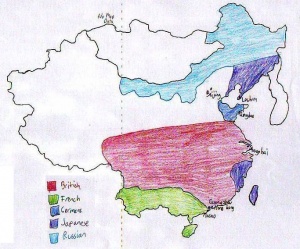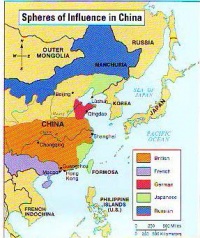World Cultures Portfolio/China
From ThePlaz.com
World Cultures China Report about Spheres of Influence
Intro/Basics - Africa - Middle East - South Asia - China - Japan - Korea - Latin America
World Cultures Daily Questions
Notebook
- Page 78 - China Political Map, Geo Notes
- Page 79 - Chinese Modern Relationships, Indian, Meanings, Page 2
- Pan Gu Myth, Cartoon, Questions and Hindu God
- Page 80 - Three Gorges Dam Article
- Page 81 - Chinese Symbols, Page 2
- Page 82 - Confucius Information, Page 2, Face, Notes
- Page 83 - Daoism Information, Page 2, Face, Notes
- Page 84 - Religion's Quote Chart
- Page 85 - Chinese Dynasties Notes, Page 2, Page 3
- Page 86 - Chinese Revolutions Notes, Page 2, Steps and Pictures, Steps Page 2
- Page 87 - Chinese Events Matching, Page 2
- Page 88 - Eastern Religions Truths, Page 2
- Page 89 - Globalization Cartoon
- Page 90 - Chinese Consumption Article
- Page 91 - Facts About China Today
- Page 92 - Mao and Now Comparison Videos (Reaction from Primary Sources)
- China Test Instructions
Portfolio
- Portfolio
- Sphere of Influences Report
- Mao Button Journal
Test/Quizzes
Africa: HDI Graph Reflections - Decolonization Report
Middle East: Population Density Report - Essay: A Peaceful Vacation
South Asia: Rainfall Report - South Asia Comparisons Graph - Postcards
China: Sphere of Influences Report - Mao Button Journal
Japan: Natural Resources Report - Japanese Violence Journal
Korea: Physical Map Report
Latin America: Landforms Report
Worldwide: T-Shirt Trade Report
China has had a long and varied history. It has one the richest pasts of any nation, but one of the most volatile presents. It's the world's largest country by population and 3rd largest by area. But its isolationist policies and geography have kept it cut off from the outside world. Thus its history stems from that isolation.
For thousands of years, China developed more or less independently due to the restrictive physical features which surround China. To the south-east, lie the Himalayas, the tallest mountains on earth. To the west lies the great Tibetan Plateau. To the north, the vast plains of Mongolia, and farther north, the barren waste lands of Siberia. To the east, lie the vast expanses of the Pacific Ocean. These natural barriers prevented outside influences from entering China.
In addition, the Chinese culturally disliked any foreigners. They looked down in contempt to anyone who tried to enter their "The Middle Kingdom." They held a view of the world which placed them right in the center. "Barbarians" lay outside at the very edge of the circle. Thus, with this air of superiority, the Chinese did not look favorably on trade with other nations. They must have felt they had everything they needed. They felt as if they alone dominated the world. Of course, when the Europeans came, the Chinese initially did not want them and treated them with an attitude. But no longer could they hold back.
As the Europeans arrived in force, it became apparent that China lost their edge and regional superiority. Initially many Asian countries tried to keep out foreign traders. However, soon the Chinese had to allow trade. However, the Chinese wanted two-way trade, but Europe didn't have anything to trade in return for porcelain, silk, spices and tea except for silver. (Wikipedia, Opium Wars). So, the British attempted to get the Chinese addicted to Opium to correct their trade imbalance (Wikipedia, Opium Wars). The Chinese attempted to outlaw Opium, (which already was forbidden in Britain) (Wikipedia, Opium Wars). The British, obviously, did not want to end the trade of the addictive and lucrative crop, and used force to try and restart trading.
However, the Chinese could not stand up to the British with their advanced warfare methods. The Chinese had to sign a series of unequal treaties (Wikipedia, Unequal Treaties). The first force the Chinese to open ports and allow Christan missionaries to preach in those port cities (Wikipedia, Unequal Treaties). Later came systems of extraterritoriality where foreign countries ruled certain areas, not subject to local laws (Wikipedia, Unequal Treaties). This angered many Chinese, but let foreigners set up bases from which to trade from.
Without going into the specifics of each father nation, indirect colonization followed similar patterns in China. The country would find a good port location and establish a city there (German Historical Museum). It would bring in experts in city planning and construction to intelligently lay out and build the city. Sometimes, they would establish their own laws in the city through extraterritoriality (Wikipedia, Unequal Treaties). The city would then branch out into the surrounding countryside. New railroads set up efficient transportation methods. Ships would travel back and forth between the countries bring boxes of goods. Due to the large amounts of foreigners, the cities began to mirror the ones in Europe in the terms of entertainment and culture.
"A sphere of influence is an area or region over which an organization or state exerts some kind of indirect cultural, economic, military or political domination" (Wikipedia, Sphere of influence). Normally, the definition specifies that a influenced place can only do the will of their masters. If a influenced area could make decisions against the wills of the influencer's, it would not get classified as a true sphere of influence. And a colony differs from sphere of influence, because in a colony the colonizer has direct, official control over a region. A sphere of influence specifies indirect control only.
Let's look at where sphere of influence existed in China at their peak. The French extended their sphere of influence over much of Southern China, near the border with India. The British influenced a large section above that, but the Japanese controlled some of that area's coastline. The Germans have a relatively small area surrounding Qindao. The Japanese extend a sphere on influence in sections of China near Korea. Finally the Russians extended their influence over a large part of northern China. Notice that no one extends their influence near the capital city of Beijing.
After the World Wars Two, however, the outsiders either could not longer keep control of their colonies and/or no longer showed interest in having many colonies. Following World War Two, as in Africa, many European nations went home and declared their former colonies independent. This brought hardship and uncertainty on some, but caused a volatile political climate afterwards.
However, imperialism in Asia only ended only 10 years ago when the British returned Hong Kong to the Chinese. After World War 2, the British kept Hong Kong as a center for capitalistic entrepreneurs avoiding persecution (Wikipedia, Hong Kong). In 1984, the British government agreed to return Hong Kong to Chinese control, much to the dismay of most of its residents (Wikipedia, Hong Kong). China agreed to a "two systems" polity where only diplomatic affairs and national defense would integrate with the capitalistic system left alone (Wikipedia, Hong Kong). Today, Hong Kong continues to thrive, and sets an example for mainland China.
Unlike some nations after ridding themselves of foreign rulers, China focused internally, on communism, and shunned the outside world. Banning their books and influences, the Chinese wanted to remain independent, but they still strove to match other nation's levels of technology. Perhaps the vast foreign influences which once gripped China, provided support for the communist revolution in China. Also the political installability it set up with the weakening of the Qing dynasty
If they liked it or not, westerners have directly, and indirectly forever altered China's future. So much of its recent past focused on Europeans coming over and taking parts of it for their own goods. Once they left, China chose to take a step away from the world. That movement did not last, and China's future now shines brightly as a global player. But overall, only relatively recently did the East even know the West existed, much less share in their technologies and trade.
Sources
- "China Comprehensive Map." Encarta. Microsoft. 9 Jan 2007 <http://encarta.msn.com/encnet/features/MapCenter/MapPrintPreview.aspx?lat=36.5539942302764&long=104.055971740852&alt=0&mapsize=Medium&mapstyle=Comprehensive&mapstyleselectedindex=0&selectedent=45&entityname=China,%20Asia>.
- "Opium Wars." Wikipedia, The Free Encyclopedia. 11 Jan 2007, 21:16 UTC. Wikimedia Foundation, Inc. 12 Jan 2007 <http://en.wikipedia.org/w/index.php?title=Opium_Wars&oldid=100072818>.
- "Extraterritoriality." Wikipedia, The Free Encyclopedia. 1 Jan 2007, 21:17 UTC. Wikimedia Foundation, Inc. 12 Jan 2007 <http://en.wikipedia.org/w/index.php?title=Extraterritoriality&oldid=97793493>.
- "Unequal Treaties." Wikipedia, The Free Encyclopedia. 8 Jan 2007, 20:25 UTC. Wikimedia Foundation, Inc. 12 Jan 2007 <http://en.wikipedia.org/w/index.php?title=Unequal_Treaties&oldid=99391538>.
- http://www.dhm.de/ausstellungen/tsingtau/tsingtau_e.html
- "Sphere of influence." Wikipedia, The Free Encyclopedia. 20 Dec 2006, 12:58 UTC. Wikimedia Foundation, Inc. 12 Jan 2007 <http://en.wikipedia.org/w/index.php?title=Sphere_of_influence&oldid=95508831>.
- "Hong Kong." Wikipedia, The Free Encyclopedia. 12 Jan 2007, 01:21 UTC. Wikimedia Foundation, Inc. 12 Jan 2007 <http://en.wikipedia.org/w/index.php?title=Hong_Kong&oldid=100126002>.




